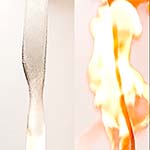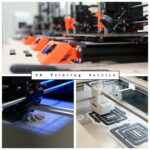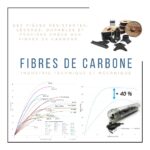
Fire resistant 3D printer filaments : norms and tests
May 11, 2023To compare the impact of fire on our 3D printer filaments, we’ve realized a typical UL94 test on 0.8 mm thick test specimens. We’ve also included two “native” materials to act as a reference point.
There are several standards and classifications when it comes to fire resistance. Nanovia filaments are available with UL94 and EN 45545-2 norms.
UL94 norm
The UL94 norm test consists of burning (+/- 1500 °C) several standardised test samples over two consecutive 10 second periods. It is done with the flame angled differently, the most frequent angle is 45 degrees for the flame, and the test specimen vertical.
The UL94 V(ertical)0 certification, shows that the material stops burning after the flame source is removed. It also shows that the material will not drip flaming drops that might ignite other sources, this is verified by a piece of cotton that is placed under the specimen.
The UL94 norm is tested on different width of test specimens : it’s harder to ignite a thicker sample. It’s frequent to see materials certified differently at different thicknesses.
EN 45545-2 norm
EN 45545-2 is a european norm to which every material used in the european railway system must adhere.
Additionally to auto extinction properties, it also required low smoke emissions and material toxicity. This norm exists to protect travellers in the case of an incident. It is also used in the aeronautical industry.
Depending on the end use, the requirements are not the same. The end usecases are noted R1 to R26. Nanovia filaments are certified according to R22 and 23 : ” interior gaskets, spools, inductance and contact spools.”
Based on the results of the fire/smoke tests, the material is certified depending on which type of transport it can be used in by risk, from H1 to H3. The H3 classification is for the most at risk vehicles: undergrounds metros.
The first difference we can make out is between PC V0 and PC-ABS V0. Both of these materials are classified V0, but at different thicknesses they do not behave the same. PC is classified V0 at 3 mm and had a flaming droplet that falls, wherass PC-ABS is certified at 1.5 mm and does not.
It’s important to note that these materials do not catch fire at the same temperature, PC with auto-inflame at 580 °C while PC-ABS only at 430 °C. Despite the less favourable UL V0 rating for PC V0, it will better shield from certain types of fire hazards.
Both PC-ABS V0 and PC-ABS Rail, are consumed relatively well compared to PC V0 and PA Rail. This consumption is demonstrated violently by the native ABS specimen that gets totally consumed engulfed in flames during the first 10 second test.
PA Rail, despite the very narrow test specimen, is hardly consumed and stops burning as soon as the source flame is removed.
Native PA reaction demonstrates the semi-crystalline nature of the material’s amorphous phase, with a progressive loss of its mechancial properties due to the heat. Instead of getting consumed, it elongates and melts, to continue burning timidly after the flame source is removed.
Polyamides have an auto-ignition points higher than ABS, depending on the variety this can surpass 500 °C.
Tags: Nanovia PA Rail, Nanovia PC V0, Nanovia PC-ABS, Nanovia PC-ABS RailCategorised in: Products


